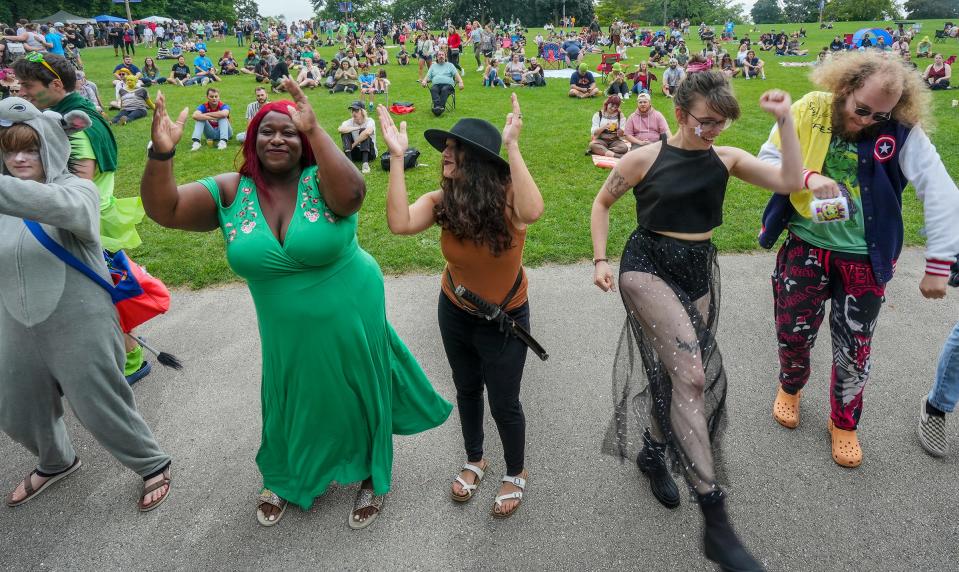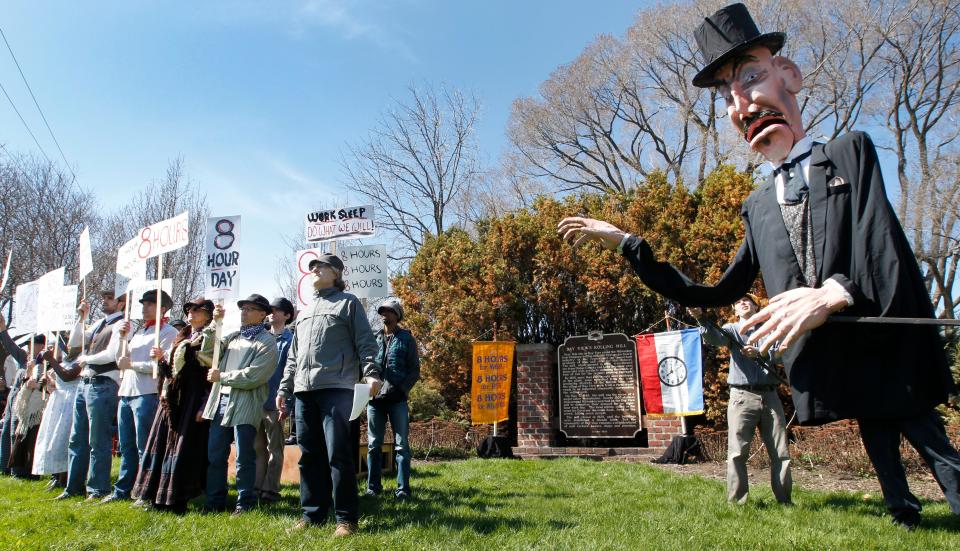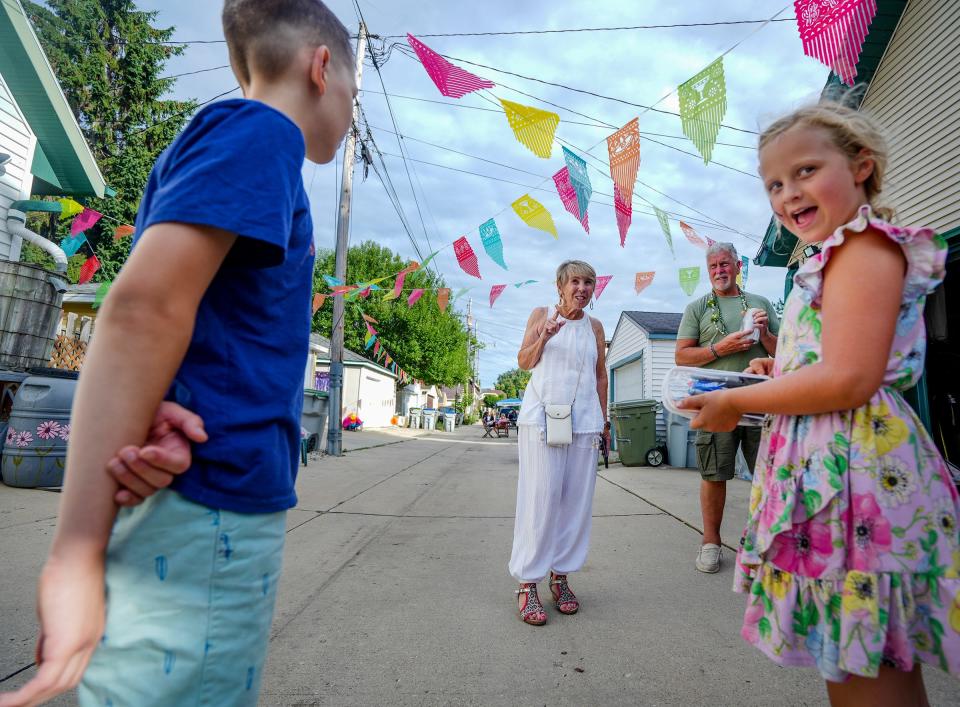Here's a guide to Milwaukee's Bay View neighborhood
Bay View is a lively neighborhood on the southeastern side of city. It's known for its bustling Kinnickinnic Avenue, lush green parks and community-driven events.
Before the neighborhood joined the city, it was a company town. Bay View's iron mill skyrocketed Milwaukee's industry growth. As a result, Bay View became a popular starting point for European immigrants.
Bay View is now home to more than 17,000 people and is rated one of the best neighborhoods in the city. Its walkability and many bars and restaurants make it a popular area for young professionals to settle.
Here's what to know about Bay View and what it has to offer.
Where is Milwaukee's Bay View neighborhood?

Bay View is on the southeastern side of Milwaukee and rests along the coast of Lake Michigan. The neighborhood's northern edge comes to a point at the Kinnickinnic River, the river and Chase Avenue flow to its west side, and Morgan Avenue marks its southern edge, according to UW-Milwaukee's Encyclopedia of Milwaukee and Urban Anthropology, Inc.
More: How many neighborhoods are there in Milwaukee? Here's why there's no 'right' answer.
Bay View was a hub for iron, steel products in the 1800s
Before Bay View joined the City of Milwaukee, it was the state's first company town. Eber Brock Ward, an entrepreneur from Detroit, purchased 30 acres of land just outside of city limits to build the Milwaukee Iron Company in 1868.
Ward built housing in walking distance of the Milwaukee Iron Company, also called the Bay View Rolling Mill, for workers to live. He recruited English, Scottish and Welsh workers from Great Britain. Ward named streets, like Potter Avenue, Clement Avenue and Russell Avenue, after mill employees.
The mill employed thousands of workers. It produced steel and iron products for the entire nation. The mill became a national leader in iron production — sparking the city's industrial growth. The Milwaukee Iron Company produced re-rolled iron rails, merchant bars, horseshoes, pig iron and nails.
After Ward died in 1875, the Milwaukee Iron Company went bankrupt, and North Chicago Rolling Mill bought it. Polish immigrants began working at the mill. The mill, like many factories at the time, required workers complete 12-hour shifts six days a week.
By 1886, workers were fed up with the long hours and low wages. The Federation of Organized Trades and Labor Unions, now called the American Federation of Labor, empowered workers to demand eight-hour workdays for the pay of 10 hours. On May 5, 1886, about 1,500 workers went on strike. State troopers, ordered by Governor Jeremiah Rusk, fired shots into the crowd of mostly Polish workers, killing seven people. It's known as the 1886 Bay View Tragedy.

A plaque commemorating this event is in Bay View at the intersection of E. Russell Avenue and S. Superior Street. It took more than 50 years for the 40-hour work week and minimum wage to be guaranteed for Milwaukee workers through the Fair Labor Standards Act of 1938, according to the Encyclopedia of Milwaukee.
Following the tragedy, Bay View residents voted in 1887 to join the City of Milwaukee. Later, streetlights and sewers were added to the neighborhood.
The Illinois Steel Company took over the mill in 1889. Italians from the mainland were drawn to the mill for work, according to UW-Milwaukee Library. G. Groppi’s Food Market, an Italian grocery store, opened in 1944 to serve their needs. The mill closed for good in 1929.
Today Bay View is a trendy neighborhood for young professionals
If you're looking for a taste of what Bay View has to offer, take a walk down Kinnickinnic Avenue. This strip is bustling with bars, restaurants and boutiques. Bay View has a lot to offer in comparison to similar neighborhoods in the state, too. It has three times more bars, five times more cafes and 14 times more yoga studios, according to the 190 Milwaukee Neighborhood project.
These hotspots have attracted young professionals. Most residents in this neighborhood are unmarried and in their mid- to late 30s, according to city-data.com. Residents are more likely to have a bachelor's degree than elsewhere in the Milwaukee Metro area.
The neighborhood has drawn the attention of apartment developers. In the past decade, more units have been built. There's interest in developing a 5.6 acre lot, known as the former Army Reserves, to add mixed-income housing to the neighborhood.
Although the majority of residents in Bay View are white, there is a growing Latino population. Latinos represent nearly 12% of the neighborhood. UMOS, a social services program that started out supporting migrant farmworkers, is headquartered in Bayview. It hosts an annual Mexican Independence Day Festival in the neighborhood.
There's a growing number of Latin eats and bars in Bay View, too. Tulum Latin Gastropub, which opened in 2022, added more Caribbean and Mexican flavors to Bay View's palate. The gastropub spotlights Latin music, too.
Parks, bars and history to experience in Bay View
This neighborhood offers hundreds of acres of green space that residents can enjoy no matter the season. The 73-acre Humboldt Park is among Bay View's most beloved park. It's named after Friedrich Wilhelm Heinrich Alexander von Humboldt, a notable naturalist and geographer. Humboldt Park's beer garden is the usual backdrop for Bay View's summer jazz festival and other community events. The park's band shell is a spot to catch live music performances. Folks from throughout the city and suburbs bring out their lawn chairs and blankets for the Chill on the Hill summer music performances. In the winter, the park's lagoon transforms into an ice skating rink.
South Shore Park's 47 acres has something for everyone. Residents can enjoy the view of Lake Michigan from the sandy shore or under shade of the pavilion. The South Shore Farmers’ Market also draws a crowd. The Oak Leaf Trail runs through the park and connects to Bay View Park. Some other parks to check out are the Kinnickinnic and Zilman Parks. Bay View's southeast corner touches the St. Francis Seminary Woods. The Seminary woods are a reminder of what the city looked like before industrialization. Its 70 lush green acres feature 120 species of native plants.
Some popular events to keep an eye on are the Bay View Bash and Fourth of July celebrations at Humboldt Park. In May, Bay View Gallery Night kicks off. The gallery night events are an opportunity to immerse yourself in art from Milwaukee artists and get to know small businesses.
If you're looking for brunch spots in the city, Bay View is a good place to start. The Centraal Grand Café & Tappery has one of the city's largest tap rooms and longest bars. Its menu is Amsterdam-inspired eats, with fish, sweets and vegetarian selections. Honeypie Cafe is a Midwestern diner with fresh pies made with Wisconsin ingredients.
There are plenty of bars in Bay View with some personality. The Mothership bar is run by "millennial weirdos" and isn't your usual corner bar. Its eclectic decorations and cocktails set it apart. At Random is a retro cocktail bar that's been mixing up drinks since 1964. Its red lighting and mid-century aesthetic are Instagramable.
For those eager to bust a move, check out the Cactus Club's event calendar. It's a queer-run, artist centered music venue and community space that almost always has something exciting on stage, whether a rock band, a DJ set or a book club.
Although Bay View has changed quite a bit since its days as a blue-collar neighborhood, historical markers of its past still stand. The Bay View Historical Society resides in the Beulah Brinton House. Brinton moved to Bay View in 1872. She was an author and opened the first library in the neighborhood in her own home. Her husband managed the Milwaukee Iron Company. Brinton helped support mill workers by teaching them English and opening her home as a gathering place following the 1886 Bay View Tragedy, according to Encyclopedia of Milwaukee.
The Beulah Brinton Community Center was named in Brinton's honor and built in the neighborhood in 1978, according to Milwaukee Recreation. The center offers programs for youth, adults and seniors.
At the 1700 block of East Pryor Avenue, west of South Superior Avenue, stands the Pryor Avenue Iron Well. The well was built in 1882, according to the City of Milwaukee. The community has fundraised to keep this public well a part of the neighborhood, but it isn't recommended to drink the well's water. The water has Strontium levels that exceed the USEPA Lifetime Health Advisory Level.

New to the neighborhood? Here’s how to access Milwaukee services
Bay View is in the 14th Aldermanic District. You can keep up with your alderperson and the 14th district at city.milwaukee.gov/CommonCouncil/CouncilMembers/District14. You can also contact District 14 Alderwoman Marina Dimitrijevic at [email protected].
Bay View is in Police District 6. The district's monthly Crime and Safety Meetings are the first Tuesday of every month at 6 p.m. The meeting locations change, so visit the District 6 Facebook page to keep up.
Find your garbage and recycling schedule at city.milwaukee.gov/sanitation/GarbageRecyclingSchedules.
Learn how to register to vote and find your polling place at city.milwaukee.gov/election/Voter-Info.
Need to borrow tools for a home improvement project? Check out the city’s Tool Loan Center, 2500 W. Capitol Drive. More details at bit.ly/MKE_ToolLoan.
Want to get emailed updates about police activity, new development and more in your neighborhood? Sign up for the city’s e-notify system at city.milwaukee.gov/News-Events/enotify.
Tell us about your Milwaukee neighborhood. We want to hear from you!
What makes your Milwaukee neighborhood special to you? Do you have any photos in the neighborhood you'd like to share? Share more at bit.ly/MKE_Neighborhoods.
Editor's Note, March 29, 2024: This story has been updated. It originally included information about an event that no longer takes place.
This article originally appeared on Milwaukee Journal Sentinel: Milwaukee's Bay View neighborhood: A guide
